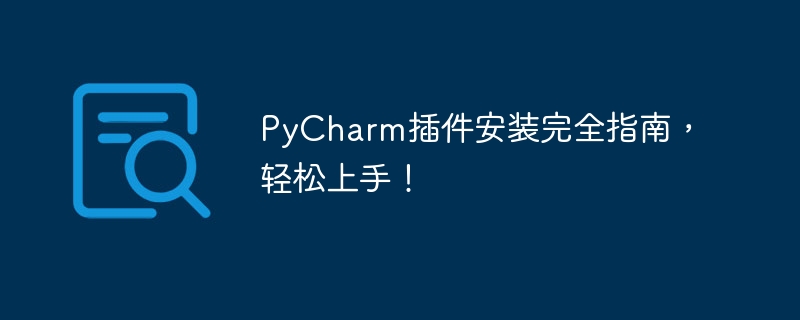Home >Backend Development >Python Tutorial >Complete Guide: How to Install PyCharm Plugin Easily
Complete Guide: How to Install PyCharm Plugin Easily
- WBOYWBOYWBOYWBOYWBOYWBOYWBOYWBOYWBOYWBOYWBOYWBOYWBOriginal
- 2024-02-26 09:39:061315browse

PyCharm is a powerful Python integrated development environment. By installing plug-ins, its functionality and efficiency can be further improved. This article will introduce you to the installation method of PyCharm plug-in in detail, and provide some common plug-in usage examples so that you can get started easily.
1. Plug-in installation method
Installing plug-ins in PyCharm is very simple, just follow the following steps:
- Open PyCharm and enter the menu bar "File" -> "Settings";
- In the pop-up window, select the "Plugins" option;
- Click the "Browse repositories..." button in the upper right corner to search for what you need Installed plug-ins;
- After finding the required plug-ins, click the "Install" button and wait for the installation to complete.
2. Commonly used plug-in examples
2.1 CodeGlance
CodeGlance is a plug-in that can display code thumbnails on the right side of the PyCharm editor, allowing you to conveniently View the structure of the entire code file.
Installation method: Search for "CodeGlance" in the plug-in market and install it.
Sample code:
def factorial(n):
if n == 0:
return 1
else:
return n * factorial(n-1)2.2 Markdown Support
The Markdown Support plug-in allows PyCharm to support document editing in markdown format, making it easier to write documents and notes.
Installation method: Search for "Markdown Support" in the plug-in market and install it.
Sample code:
# Markdown示例 这是一段**加粗**的文本。 - 列表项1 - 列表项2 - 列表项3
2.3 Rainbow Brackets
Rainbow Brackets can display bracket pairs in PyCharm in different colors to help you better identify code levels.
Installation method: Search for "Rainbow Brackets" in the plug-in market and install it.
Sample code:
if n == 0:
print("Zero")
else:
if n % 2 == 0:
print("Even")
else:
print("Odd")2.4 GitToolBox
The GitToolBox plug-in integrates the functions of Git, allowing you to manage code versions directly in PyCharm.
Installation method: Search for "GitToolBox" in the plug-in market and install it.
Sample code:
$ git add . $ git commit -m "Update" $ git push origin master
By installing the above plug-ins, PyCharm can be more functional and work more efficiently. I hope the content of this article can help you get started with the installation and use of the PyCharm plug-in more easily.
The above is the detailed content of Complete Guide: How to Install PyCharm Plugin Easily. For more information, please follow other related articles on the PHP Chinese website!

